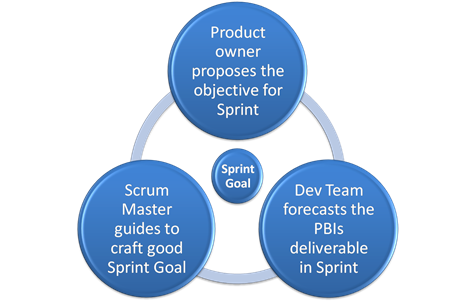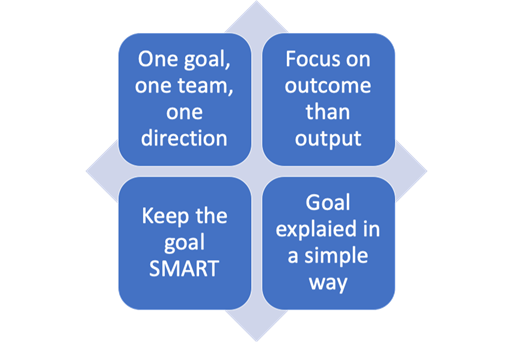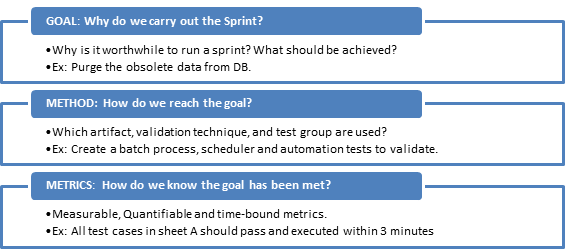After adopting scrum, do you still find the dearth of collaboration among team members? In your scrum ceremonies, do you still hear more “I”s than “We”s? Team members are still worried about their respective tasks only, based on their personal preference or assigned to them. Your daily scrum is just a status update meeting rather than an opportunity to discuss a common vision? Then, most probably your scrum process might be missing a crucial ingredient called ‘Sprint Goal’.
A sprint goal is a mandatory concept in the scrum and defines the purpose of a sprint and provides a shared objective to the team. As per the Scrum guide, the sprint goal is an objective that will be met within the Sprint through implementing the product backlog, and it provides guidance to the Development Team on why it is building the Increment.
Who crafts a Sprint Goal?
Each role (Product Owner, Development Team, and Scrum Master) in the scrum plays a crucial role in crafting a good Sprint Goal as outlined below.

- The product owner defines and decides the priority of product backlog items. During the sprint planning meeting, the product owner proposes the objective of the coming sprint and outlines the backlog items that will help to achieve this objective. But this objective cannot be a final sprint goal.
- The development team knows how much they can work on to achieve the proposed sprint objective. They refine this objective further based on their experience, strengths, and weakness and create the sprint increment.
- As a servant leader, the scrum master guides the development team and the product owner to come up with a good sprint goal during the sprint planning meeting.
Why is a Sprint Goal important?
- The purpose of a sprint is to achieve a business outcome. Without a goal, the sprint just becomes the time-boxed period to achieve as many irrelevant backlog items as possible. In effect, the scrum team is creating many promises to many stakeholders. The scrum team just becomes a feature factory churning out streams of unrelated features.
- In a sprint without a shared goal, there is no obvious reason for team members to collaborate. Team members will pick up their own items from the sprint backlog and start working on that where self-organization will be limited. Sprint goal nurtures team-building by collaborating towards a shared goal.
- A sprint goal guides the product owner on prioritizing the backlog items for the sprint and helps the team to identify the right product backlog items. This will make the sprint a goal-driven one rather than backlog driven sprint.
- A goal-oriented daily scrum ensures the team’s focus on a shared objective and leads to a healthy discussion on how to achieve it. Without a shared objective defined for the team, the daily scrum becomes a status update meeting driven by individual preferences. In essence, we hear more “I”s than “We”s.
- Sprint review driven by the sprint goal helps the stack holders to identify easily if the sprint met its purpose and has answered the defined market conditions. Without a sprint goal, the review will be just a demo of all sprint backlog items completed within that sprint.
- During the Retrospective meeting, the development team can easily measure the Sprint if it is successful or not regarding a drafted sprint goal and discuss how to improve as a team to deliver the sprint goal.
- A sprint goal promotes product backlog cohesion which provides a focus that helps the product owner to decide backlog items that work well together, and devise a product roadmap.
- Whenever the sprint team is in doubt on what next to pickup during the sprint, the sprint goal will guide the team on efficient decision-making and ensures that they are doing the right things.
What are the characteristics of a good sprint goal?

- In the ideal situation, every sprint should have only one sprint goal be defined. This ensures that the entire team-work in one direction. Multiple goals drift the team’s focus and direction.
- The agenda of the sprint goal is to focus effort on the outcome rather than output. The outcome-based sprint goal emphasizes more on the product’s new or improved capability being developed over the number of stories getting done.
- The goal should be specific, realistic, measurable, quantifiable, relevant, and time-bound. This will help all team members to understand the sprint goal in the same context.
- The sprint goal should be one or two sentences circumventing the most import aspects of the sprint backlog.
How to draft the sprint goal?
To craft an effective sprint goal, renowned product management expert Roman Pichler suggests following three questions to consider:

Using above example, we can draft a sprint goal like below,
“Purge the obsolete data from DB using a scheduler that runs within 3 minutes”.
Some more good examples,
- Migrate the deployment of application x from weblogic 12.1 to 12.2.
- Enhance dashboard table with sort, search and download features.
- Provide estimations for the features 10-18 and fix all priority one bugs from previous release.
Sprint Goal: Key Challenges
Crafting a good sprint goal is not always easy. Here are a few examples of how to craft a sprint goal with various kinds of sprint backlog items.

Too many unrelated items in the sprint: Try to figure out along with product owner the most important coherent items and draft the sprint goal encompassing the finalized list. It is not advisable to include every sprint item in the sprint goal if they are not related.
The sprint goal turned out to be too big: A larger sprint goal deviates the team’s focus, hence, should be refined again until it becomes the one or two sentence goal and ensures that all team members are on the same understanding with the statement.
The sprint goal does not meet the SMART criteria: The foremost criteria for the sprint goal is, each team member in the scrum team should have the same understanding regarding its definition of done. If this is met, a certain level of relaxation on SMART criteria is acceptable.
Where to display the Spring Goal?
Spring Goal should be visible to the team throughout the sprint in all scrum ceremonies as it has an important role to play in all of them. Write the sprint goal in a prominent place like on a wall in the daily scrum discussion room or at a central place near the team’s workplace which enables the team to talk about their journey towards sprint goal regularly.
If the scrum team uses, JIRA or Kanban board to monitor their daily scrum, they can create a task with the sprint goal and monitor regularly along with all other sprint items.
In summary, a good sprint goal acts as a driver for intrinsic motivation, helps the development team understand the purpose and impact of the work they are doing. As a product’s vision guides the long-term direction of a product, the sprint goal guides the scrum team on why it is building the running sprint.




